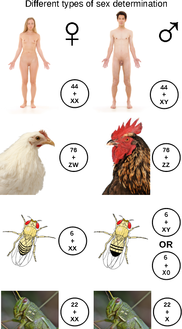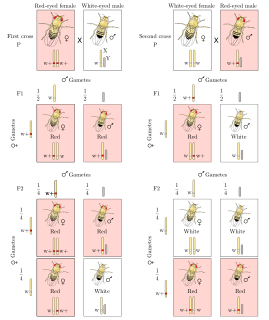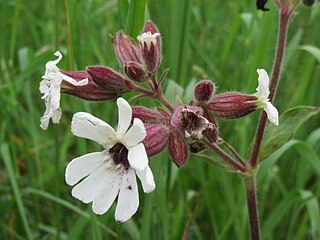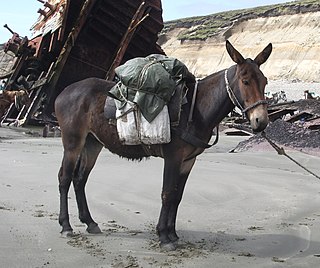
A chromosome is a deoxyribonucleic acid (DNA) molecule with part or all of the genetic material (genome) of an organism. Most eukaryotic chromosomes include packaging proteins which, aided by chaperone proteins, bind to and condense the DNA molecule to prevent it from becoming an unmanageable tangle.
Selfish genetic elements are genetic segments that can enhance their own transmission at the expense of other genes in the genome, even if this has no positive or a net negative effect on organismal fitness. Genomes have traditionally been viewed as cohesive units, with genes acting together to improve the fitness of the organism. However, when genes have some control over their own transmission, the rules can change, and so just like all social groups, genomes are vulnerable to selfish behaviour by their parts.

A sex-determination system is a biological system that determines the development of sexual characteristics in an organism. Most organisms that create their offspring using sexual reproduction have two sexes. Occasionally, there are hermaphrodites in place of one or both sexes. There are also some species that are only one sex due to parthenogenesis, the act of a female reproducing without fertilization.

The Y chromosome is one of two sex chromosomes (allosomes) in mammals, including humans, and many other animals. The other is the X chromosome. Y is the sex-determining chromosome in many species, since it is the presence or absence of Y that determines the male or female sex of offspring produced in sexual reproduction. In mammals, the Y chromosome contains the gene SRY, which triggers testis development. The DNA in the human Y chromosome is composed of about 59 million base pairs. The Y chromosome is passed only from father to son. With a 30% difference between humans and chimpanzees, the Y chromosome is one of the fastest-evolving parts of the human genome. To date, over 200 Y-linked genes have been identified. All Y-linked genes are expressed and hemizygous except in the cases of aneuploidy such as XYY syndrome or XXYY syndrome.

Sex linkage describes the patterns of inheritance and presentation when a mutated gene is present on a sex chromosome rather than a non-sex chromosome. They are characteristically different from the autosomal forms of dominance and recessiveness.

Michael Ashburner is a biologist and Emeritus Professor in the Department of Genetics at University of Cambridge. He is also the former joint-head and co-founder of the European Bioinformatics Institute (EBI) of the European Molecular Biology Laboratory (EMBL) and a Fellow of Churchill College, Cambridge.
Intragenomic conflict refers to the evolutionary phenomenon where genes have phenotypic effects that promote their own transmission in detriment of the transmission of other genes that reside in the same genome. The selfish gene theory postulates that natural selection will increase the frequency of those genes whose phenotypic effects cause their transmission to new organisms, and most genes achieve this by cooperating with other genes in the same genome to build an organism capable of reproducing and/or helping kin to reproduce. The assumption of the prevalence of intragenomic cooperation underlies the organism-centered concept of inclusive fitness. However, conflict among genes in the same genome may arise both in events related to reproduction and altruism.

Drosophila simulans is a species of fly closely related to D. melanogaster, belonging to the same melanogaster species subgroup. Its closest relatives are D. mauritiana and D. sechellia.
Meiotic drive is a type of intragenomic conflict, whereby one or more loci within a genome will affect a manipulation of the meiotic process in such a way as to favor the transmission of one or more alleles over another, regardless of its phenotypic expression. More simply, meiotic drive is when one copy of a gene is passed on to offspring more than the expected 50% of the time. According to Buckler et al., "Meiotic drive is the subversion of meiosis so that particular genes are preferentially transmitted to the progeny. Meiotic drive generally causes the preferential segregation of small regions of the genome".
The Drosophila melanogaster species subgroup contains 9 species of flies, including the best known species Drosophila melanogaster and D. simulans. The subgroup belongs to the Drosophila melanogaster species group within the subgenus Sophophora.
The mechanisms of reproductive isolation are a collection of evolutionary mechanisms, behaviors and physiological processes critical for speciation. They prevent members of different species from producing offspring, or ensure that any offspring are sterile. These barriers maintain the integrity of a species by reducing gene flow between related species.
A metafemale is a low viability Drosophila fruit fly with a female phenotype in which the ratio of X chromosomes to sets of autosomes (A) exceeds 1.0. For example: a fly with one X chromosome and two sets of autosomes is a normal male, a fly with two X chromosomes and two sets of autosomes is a normal female, and a fly with three X chromosomes and two sets of autosomes is a metafemale.

Heterogametic sex refers to the sex of a species in which the sex chromosomes are not the same. For example, in humans, males, with an X and a Y sex chromosome, would be referred to as the heterogametic sex, and females having two X sex chromosomes would be referred to as the homogametic sex.
Cytoplasmic male sterility is total or partial male sterility in plants as the result of specific nuclear and mitochondrial interactions. Male sterility is the failure of plants to produce functional anthers, pollen, or male gametes.

Silene are a flowering plant that evolved a dioecious reproductive system. This is made possible through heteromorphic sex chromosomes expressed as XY. Silene recently evolved sex chromosomes 5-10 million years ago and are widely used by geneticists and biologists to study the mechanisms of sex determination since they are one of only 39 species across 14 families of angiosperm that possess sex-determining genes. Silene are studied because of their ability to produce offspring with a plethora of reproductive systems. The common inference drawn from such studies is that the sex of the offspring is determined by the Y chromosome.












